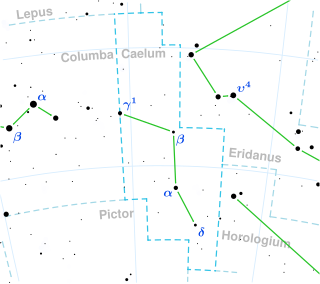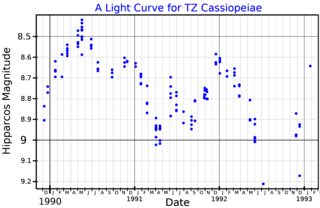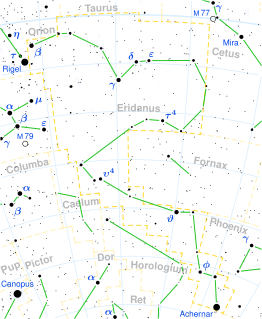Related Research Articles

Delta Cephei is the Bayer designation for a quadruple star system located approximately 887 light-years away in the northern circumpolar constellation of Cepheus, the King. At this distance, the visual magnitude of the star is diminished by 0.23 as a result of extinction caused by gas and dust along the line of sight. It is the prototype of the Cepheid variable stars that undergo periodic changes in luminosity.

ν Tauri, Latinized as Nu Tauri, is a single star in the zodiac constellation of Taurus. It is a white-hued star and is visible to the naked eye with an apparent visual magnitude of +3.91. This object is located 117 light years from the Sun based on parallax, but is drifting closer with a radial velocity of −6 km/s. It is predicted to come to within roughly 18.4 ly of the Sun in around five million years.

Eta Tucanae, Latinized from η Tucanae, is a probable binary star system in the southern constellation of Tucana, a few degrees to the north of Epsilon Tucanae. It is visible to the naked eye as a dim, white-hued point of light with an apparent visual magnitude of +5.00. parallax measurements provide a distance estimate of about 154 light years from the Sun, and it is drifting further away with a mean radial velocity of +32.5 km/s. It is a member of the 30 million year old Tucana-Horologium association of co-moving stars.

26 Arietis is a variable star in the northern constellation of Aries. 26 Arietis is the Flamsteed designation; it also bears the variable star designation UU Arietis. The apparent visual magnitude of this star is 6.14, which, according to the Bortle Dark-Sky Scale, is within the naked eye visibility limit in dark rural skies. The annual parallax shift of 13.78 mas is equivalent to a distance of approximately 215 light-years from Earth. The star is receding from the Earth with a heliocentric radial velocity of +15 km/s.
KW Sagittarii is a red supergiant, located approximately 1,900 parsecs away from our Sun in the direction of the constellation Sagittarius. It is one of the largest-known stars. If placed at the center of the Solar System, the star's surface would engulf Mars.

Zeta Cephei is a star in the constellation of Cepheus. Zeta Cephei marks the left shoulder of Cepheus, the King of Joppa (Ethiopia). It is one of the fundamental stars of the MK spectral sequence, defined as type K1.5 Ib.
Epsilon Cephei, Latinized from ε Cephei, is a star in the northern constellation of Cepheus. Based upon an annual parallax shift of 38.17 mas as seen from the Earth, it is located about 85 light years from the Sun. The star is visible to the naked eye with an apparent visual magnitude of 4.18.

RV Caeli is a red giant star in the constellation Caelum. With an apparent magnitude of 6.4, it's barely visible to the naked eye, but this can vary. RV Caeli has a high radial velocity, which means it's moving away from the Solar System, and is currently located 1,200 light-years (370 pc) away using parallax.
HD 4778, also known as HR 234 and GO Andromedae, is a variable star in the constellation Andromeda. Its magnitude varies by 0.04 magnitudes from the median of 6.12 with a period of approximately 2.55 days. The star is located 350 light years away, as determined from its annual parallax shift of 9.32 mas.
LN Andromedae, also known as HD 217811, HR 8768, is a formerly suspected variable star in the constellation Andromeda. Located approximately 458 parsecs (1,490 ly) away from Earth, it shines with an apparent visual magnitude 6.41, thus it can be seen by the naked eye under very favourable conditions. Its spectral classification is B2V, meaning that it's a hot main sequence star, emitting light approximately with a blackbody spectrum at an effective temperature of 18,090 K.

RW Cephei is a hypergiant variable star in the constellation Cepheus, at the edge of the Sharpless 132 HII region and close to the small open cluster Berkeley 94. One of the largest stars known, RW Cephei's radius is more than 1,000 times that of the Sun (R☉), thus larger than the orbit of Jupiter.

TZ Cassiopeaie(TZ Cas, HIP 117763, SAO 20912) is a variable star in the constellation Cassiopeia with an apparent magnitude of around +9 to +10. It is approximately 8,400 light-years away from Earth. The star is a red supergiant star with a spectral type of M3 and a temperature below 4,000 K.
Omega1 Cygni, Latinized from ω1 Cygni, is the Bayer designation for a solitary star in the northern constellation of Cygnus. It is visible to the naked eye with an apparent visual magnitude of 4.94. Based upon an annual parallax shift of 2.59 mas, it is estimated to lie roughly 1,260 light years from the Sun. Relative to its neighbors, this star has a peculiar velocity of 25.7±2.2 km/s.

HD 93194 is a star in the constellation Carina. Its apparent magnitude is 4.79. Its parent cluster is IC 2602.

f Eridani is a binary, or possibly a triple, star system in the equatorial constellation of Eridanus, consisting of stars HD 24071 and HD 24072. They share a single Hipparcos catalogue entry, HIP 17797, but have separate Bright Star Catalogue listings, HR 1189 and 1190. f Eridani is the Bayer designation of the pair.
Tau1 Hydrae is a triple star system in the equatorial constellation of Hydra. Based upon the annual parallax shift of the two visible components as seen from Earth, they are located about 18 parsecs (59 ly) from the Sun. The system has a combined apparent visual magnitude of +4.59, which is bright enough to be visible to the naked eye at night.

32 Persei is a single star located 149 light years away from the Sun in the northern constellation of Perseus. It has the Bayer designation of l Persei, while 32 Persei is the Flamsteed designation. This object is visible to the naked eye as a faint, white-hued star with an apparent visual magnitude of 4.96. It is moving closer to the Earth with a heliocentric radial velocity of −9 km/s, and is a member of the Sirius supercluster: a stream of stars that share a common motion through space.

HD 21278 is a binary star system in the constellation Perseus, located within the 60±7 million year old Alpha Persei Cluster. It has a blue-white hue and is visible to the naked eye with a combined apparent visual magnitude of 4.99. The system is located at a distance of approximately 580 light years from the Sun based on parallax, and it is drifting further away with a radial velocity of +1.20 km/s.

29 Persei is a single star in the northern constellation of Perseus, located approximately 640 light years away from the Sun based on parallax. It is visible to the naked eye as faint, blue-white hued star with an apparent visual magnitude of 5.16. This object is a member of the Alpha Persei Cluster.

BW Vulpeculae or BW Vul, is a variable star in the northern constellation of Vulpecula. It is near the lower limit of visibility to the naked eye with a typical apparent visual magnitude of 6.54. Based on an annual parallax shift of 1.15 mas, the distance to BW Vul is about 2,800 light years. It is moving closer to the Earth with a baseline heliocentric radial velocity of around −6 km/s.
References
- 1 2 3 4 5 6 Vallenari, A.; et al. (Gaia Collaboration) (2022). "Gaia Data Release 3. Summary of the content and survey properties". Astronomy & Astrophysics . arXiv: 2208.00211 . doi: 10.1051/0004-6361/202243940 . Gaia DR3 record for this source at VizieR.
- 1 2 Oja, T. (August 1991). "UBV photometry of stars whose positions are accurately known. VI". Astronomy and Astrophysics Supplement Series. 89: 415. Bibcode:1991A&AS...89..415O. ISSN 0365-0138.
- ↑ Abt, Helmut A.; Morrell, Nidia I. (1995). "The Relation between Rotational Velocities and Spectral Peculiarities among A-Type Stars". Astrophysical Journal Supplement. 99: 135. Bibcode:1995ApJS...99..135A. doi:10.1086/192182.
- ↑ Anderson, E.; Francis, Ch. (2012). "XHIP: An extended hipparcos compilation". Astronomy Letters. 38 (5): 331. arXiv: 1108.4971 . Bibcode:2012AstL...38..331A. doi:10.1134/S1063773712050015. S2CID 119257644.
- 1 2 3 4 5 Stassun, Keivan G.; et al. (2019-10-01). "The Revised TESS Input Catalog and Candidate Target List". The Astronomical Journal. 158 (4): 138. Bibcode:2019AJ....158..138S. doi:10.3847/1538-3881/ab3467. hdl: 1721.1/124721 . ISSN 0004-6256. S2CID 166227927.
- ↑ Anders, F.; Khalatyan, A.; Chiappini, C.; Queiroz, A. B.; Santiago, B. X.; Jordi, C.; Girardi, L.; Brown, A. G. A.; Matijevič, G.; Monari, G.; Cantat-Gaudin, T.; Weiler, M.; Khan, S.; Miglio, A.; Carrillo, I.; Romero-Gómez, M.; Minchev, I.; De Jong, R. S.; Antoja, T.; Ramos, P.; Steinmetz, M.; Enke, H. (2019). "Photo-astrometric distances, extinctions, and astrophysical parameters for Gaia DR2 stars brighter than G = 18". Astronomy and Astrophysics. 628: A94. arXiv: 1904.11302 . Bibcode:2019A&A...628A..94A. doi:10.1051/0004-6361/201935765. S2CID 131780028.
- 1 2 David, Trevor J.; Hillenbrand, Lynne A. (2015). "The Ages of Early-Type Stars: Strömgren Photometric Methods Calibrated, Validated, Tested, and Applied to Hosts and Prospective Hosts of Directly Imaged Exoplanets". The Astrophysical Journal. 804 (2): 146. arXiv: 1501.03154 . Bibcode:2015ApJ...804..146D. doi:10.1088/0004-637X/804/2/146. S2CID 33401607.
- ↑ "V* V Cep". SIMBAD . Centre de données astronomiques de Strasbourg . Retrieved August 17, 2010.
- ↑ Hoffleit, Dorrit (1985). "Was Harlow Shapley Right About V Cephei?". The Journal of the American Association of Variable Star Observers. 14 (2): 64–66. Bibcode:1985JAVSO..14...64H.
- ↑ Fortier, George (1989). "Photoelectric Photometry of V Cephei". The Journal of the American Association of Variable Star Observers. 18 (1): 49–51. Bibcode:1989JAVSO..18...49F.